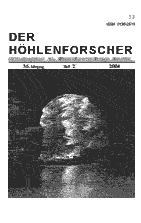
The saxon speleological newsletter
DER HÖHLENFORSCHER (The Caver)
has been continuously published since 1962
now yearly in 3 issues (96 pp.)
10,00 EUR
All issues are available.
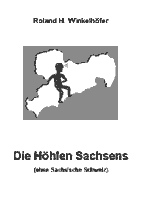
Roland H. WINKELHÖFER
Die Höhlen Sachsens (without Saxon Switzerland)
(2004)
140 pp, ring binder,
69 coloured and b/w-pictures, surveys and maps
ISBN 3-00-013063-2
20,00 EUR
The caves of Saxony are described (without the Saxon Switzerland) in
thisbook.
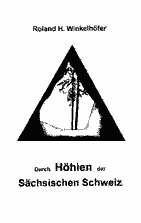
Roland H. WINKELHÖFER
Durch Höhlen der Sächsischen Schweiz
(Caves of Saxon Switzerland)
actual print, 170 pp numerous surveys, ring binder
ISBN 3-00-002609-6
20,00 EUR
Through the caves of Saxon Switzerland is a very detailed guide book to a historical caving area just south of Dresden in the state of Saxony, near the Czech border. This is an area of contrasts: where the Elbe flows through a deep gorge, surrounded by fields and forests. Above, is a high sandstone plateau, eroded into a tower karst landscape in miniature. This was the country of the "Robber Barons" and caves have been cunningly integrated into castles and other defence systems. The earliest record dates from 1474, whilest many l6th century maps showed the location of caves. The oldest inscription is in the Diebskeller [or Thieves Cellar] and dates from 1574 also there is an account of a tourist visit there in 1692. From 180l onwards numerous guide books was gave accounts of some caves in this area.
For example in 1912 Griebens ”Book for Travellers” recalled 18 caves in Saxony and 3 in Bohemia. 1920 saw the formation of the Saxony Caving Federation, one of the oldest caving clubs in Central Europe. Cave exploration and research continued. Later highlights included the publication in 1962 of a list of 100 caves. In 1969 there appeared the first issue of a Dresden newsletter called DER HÖHLENFORSCHER (The Caver) which is still being published today.
All the usual topics are covered: Cave Conservation. Equipment, Safety precautions. Biology, both Flora and Fauna and use of a Visitors Book.
This current guide book lists over 300 sandstone caves and describes the numerous (sandstone-)karst features: bedding planes, rifts or joints which are caused by either corrosion (solution), erosion (mechanical activity), or tectonics (collapse).
A very detailed guide, a must for any visitor to this area. (by Tony Oldham, Wales in: THE BRITISH CAVER Vol 122 Spring 1999)
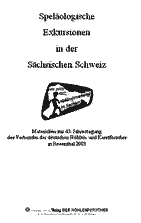
Roland H. WINKELHÖFER
Speläologische Exkursionen
in der Sächsischen Schweiz
(2003/2012)
45 pp, ring-binder
12 pictures, surveys and maps
7,00 EUR
A guidebook for walkers und cavers through the landscape of sandstone.
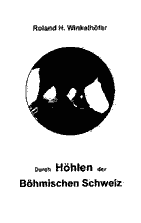
Roland H. WINKELHÖFER:
Durch Höhlen der Böhmischen Schweiz
(Caves of Bohemian Switzerland)
Cave guide and documentaion of register (1997 / 2006)
actual print
154 pp, 38 pictures, 50 surveys and maps, ring-binder
ISBN 3-00-002317-8
20,00 EUR
For the first time – a speleological monography of more than 80 Bohemian sandstone-caves. The exploration started 1911. There is the biggest fissure-cave of Europe. The guide is the most detailed publication of this area, interesting for cavers as well as climbers, friends of nature and walkers.
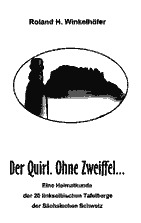
Roland H. WINKELHÖFER:
Der Quirl. Ohne Zweiffel...
(The „Table-Mountain-Book“)
Local studies of the 20 table-mountains in Saxon Switzerland,
Dresden (2010)
154 pp, many maps, 9 coloured and 64 b/w-pictures,
ring-binder
ISBN 3-00-004380-2
23,00 EUR
This is a monography of the table mountains of the Saxon sandstone-landscape, one of the finest in Europe. The region has been a popular tourist attraction for many years and this thorough description contains all points of view, geology, historic and touristic development as well as 90 caves, which are in these mountains, for the first time.
The book tells many "stories", based on well investigated documents from more than 400 years. The handbook is written for friends of nature and walking, tourists, cavers, geologists and botanists.
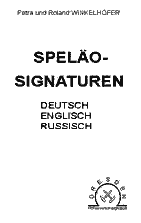
SPELÄO – SIGNATUREN
14 pp, 2nd edition (1992)
1,50 EUR
A detailed table of the required signatures in German, English and Russian.
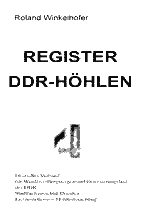
58 pp. (1982)
7,50 EUR
Declared as a list of content of the saxon speleological newsletter DER HÖHLENFORSCHER it was print under communistic dictatorship and supervision, to print this complete overview for all caves of Eastern Germany.
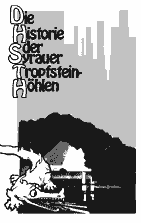
Die Historie der Syrauer Tropfsteinhöhlen
(The history of the Syrau Showcave)
25 pp. (1993)
2,00 EUR
is a reprint of an old poem (with humorous pictures), concerning the opening of the showcave Drachenhöhle
Syrau 1928.
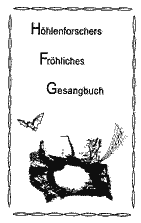
Höhlenforschers Fröhliches Gesangbuch ("HFG")
2nd edition (2013)
5,00 EUR
Around the camp fire: 66 songs for German and international cavers.
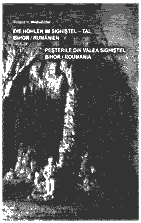
Die Höhlen im Sighistel-Tal,
Bihor / Rumänien
Dresden (2004/2006/2012)
6,00 EUR
This pamphlet in your hand – you will find all these hidden caves in the wonderfull valley above the village Sighistel.
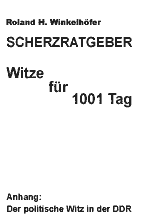
Roland H. WINKELHÖFER
SCHERZRATGEBER – Witze für 1001 Tag
(App.: Political jokes in the GDR)
78 pp
6,00 EUR
You need any help for your social life? This book contains 1001 jokes, and an index of 1400 words, to find the jokes. Supplementary 20 pages with political jokes, maintained from the time of German Dem. Rep..
Ordering adress:
![]()
![]()
![]()
![]()
![]()
![]()
Here also you can get further information about guided tours and something special about events of Roland Winkelhöfer and his group.